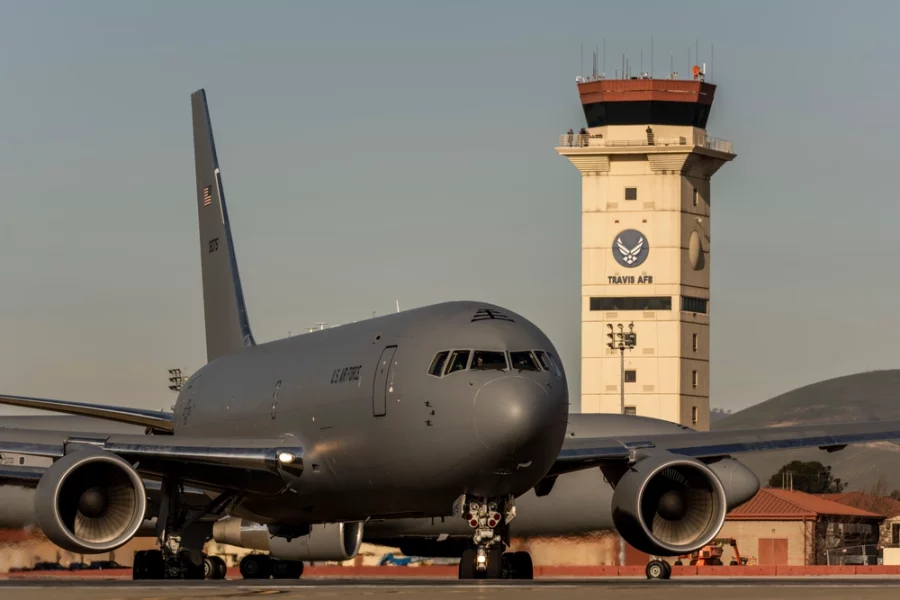Travis Air Force Base, Calif., became the sixth main operating base for the KC-46 on July 28, receiving its first Pegasus tanker—also the first accepted by the Air Force from Boeing since March, when a fuel tank problem halted deliveries.
A ceremony commemorating the event at the base also marked the 80th anniversary of the founding of Travis; the 75th anniversary of the 60th Air Mobility Wing; and the 100th anniversary of aerial refueling. Travis is trading its KC-10 Extender tanker/cargo aircraft for the Pegasus.
Boeing, in its second-quarter earnings call earlier this week, said it had resumed deliveries of the KC-46, which had been on hold since March due to a quality process problem with Boeing subcontractor Triumph Aerostructures. The center fuel tank interiors had not been properly cleaned and primed, causing concern that paint could flake off and contaminate the aircraft’s fuel system. Boeing CEO David Calhoun said the company has “completed the rework” necessary to fix the problem. Affected aircraft were deemed safe to fly during the corrective process with close monitoring of their fuel filters.
Boeing needs to deliver 15 KC-46s this year under its contract with the Air Force, but the Travis aircraft is only the second in 2023. The company has not said whether it expects to deliver all the required aircraft by the end of December.
Maj. Gen. Corey J. Martin, commander of 18th Air Force, said at the welcoming ceremony that the KC-46 goes beyond the KC-10 in that, while it can do air refueling, cargo, and aeromedical evacuation missions, it has “the brains [for] far more.”
“It’s the connections, it’s the sensors, it’s the survivability,” Martin said. The Pegasus has “the tactical situational awareness systems. It has the radios that will link this mobility aircraft to bombers, fighters, intelligence, surveillance and reconnaissance; to space, to special operations. It has systems that will detect and avoid radar-guided surface-to-air threats. It has systems that will detect and defeat infrared guided surface-to-air threats; all while maneuvering our Joint force closer to contested airspace than any KC aircraft has done in the past.”
Besides the primary missions of air refueling, cargo movement, and aeromedical evacuation, the Air Force plans to fit its KC-46s with communications and connectivity gear to make them a kind of airborne internet provider in the battlespace, as part of the service’s evolving Air Battle Management System. These changes were included in recent contracts for the KC-46 Block 1 upgrade.
The aircraft delivered to Travis is the 70th KC-46 to become operational for the Air Force, against a total order of 179 aircraft due to be delivered by 2028. The Air Force said the Pegasus has flown more than 16,000 sorties and delivered more than 150 million pounds of fuel, despite being at least a year away from the planned declaration of initial operational capability.
All 59 KC-10s in the Air Force are set to retire by September 2024 or sooner. The last East-Coast KC-10s retired from Joint Base McGuire-Dix-Lakehurst, New Jersey in June. Travis was picked to get the KC-46 in a 2017 Air Force decision; the base is slated to receive 27 of the new tankers.
In preparation for the Pegasus’ arrival at Travis, the Air Force built a $137 million, 174,300-square-foot, three-bay hangar; the largest among several new-build or renovation projects at the facility worth a collective $188 million. Construction was paused in 2020 due to the COVID pandemic, and the first KC-46 arrival was postponed from January 2023 as a result.
The KC-46 recently participated in the recent Mobility Guardian 23 exercise, as well as the Juniper Oak exercise with Israel. Air Force tankers have also been making flyovers of ceremonies and sporting events all summer to commemorate the centennial of aerial refueling.
The first aerial refueling took place on June 27, 1923, over Rockwell Field, San Diego, Calif., when two Army Air Service pilots passed fuel from their Boeing-built de Havilland DH-4B to another, using simple gravity flow. Using this technique the same group of pilots set a flying endurance record of 37 hours a few weeks later. Air refueling in the coming years was largely used to support endurance records—notably, Maj. Carl Spaatz and the Question Mark set a record of 150 hours and 40 minutes in 1937—but it was not until Spaatz became the first Chief of Staff of the Air Force that aerial refueling was pursued with serious operational purpose. Spaatz directed the conversion of some B-29s to tanker configuration in 1948, and the first air refueling units stood up in 1949.

